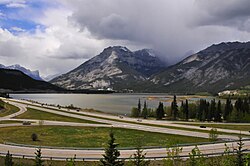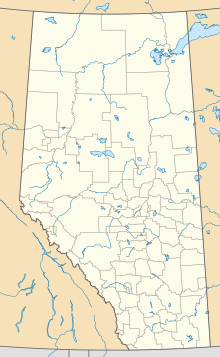Lac des Arcs, Alberta
Lac des Arcs | |
|---|---|
 | |
Location of Lac des Arcs in Alberta | |
| Coordinates: 51°03′06″N 115°09′23″W / 51.0517°N 115.1564°W | |
| Country | Canada |
| Province | Alberta |
| Census division | No. 15 |
| Municipal district | MD of Bighorn No. 8 |
| Government | |
| • Type | Unincorporated |
| • Governing body | MD of Bighorn No. 8 Council |
| Area (2021)[1] | |
| • Land | 0.57 km2 (0.22 sq mi) |
| Elevation | 1,320 m (4,330 ft) |
| Population (2021)[1] | |
| • Total | 146 |
| • Density | 256.2/km2 (664/sq mi) |
| Time zone | UTC−7 (MST) |
| • Summer (DST) | UTC−6 (MDT) |
Lac des Arcs is a hamlet in Alberta, Canada within the Municipal District (MD) of Bighorn No. 8.[2] It is located on the south side of the Bow River opposite the Hamlet of Exshaw and has an elevation of 1,320 metres (4,330 ft). Highway 1 (the Trans-Canada Highway) borders Lac des Arcs on the south.
The hamlet is located in Census Division No. 15 and in the federal riding of Wild Rose.
Lake
[edit]The wide span of the Bow River adjacent to the Hamlet of Lac des Arcs is also referred to as a lake under the same name, which attracts wind surfers and fishers. The Lafarge Exshaw Plant, a limestone quarry, is developed on the lake's northern shore.
Demographics
[edit]In the 2021 Census of Population conducted by Statistics Canada, Lac Des Arcs had a population of 146 living in 57 of its 82 total private dwellings, a change of 12.3% from its 2016 population of 130. With a land area of 0.57 km2 (0.22 sq mi), it had a population density of 256.1/km2 (663.4/sq mi) in 2021.[1]
As a designated place in the 2016 Census of Population conducted by Statistics Canada, Lac Des Arcs had a population of 130 living in 53 of its 83 total private dwellings, a change of -9.7% from its 2011 population of 144. With a land area of 0.52 km2 (0.20 sq mi), it had a population density of 250.0/km2 (647.5/sq mi) in 2016.[12]
See also
[edit]References
[edit]- ^ a b c d "Population and dwelling counts: Canada and designated places". Statistics Canada. February 9, 2022. Retrieved February 10, 2022.
- ^ Alberta Municipal Affairs (April 1, 2010). "Specialized and Rural Municipalities and Their Communities" (PDF). Archived from the original (PDF) on February 29, 2012. Retrieved June 20, 2010.
- ^ 1971 Census of Canada: Population (PDF). Special Bulletin: Unincorporated Settlements. Vol. Bulletin SP—1. Ottawa: Statistics Canada. 1973. Retrieved September 25, 2024.
- ^ "Geographical Identification and Population for Unincorporated Places of 25 persons and over, 1971 and 1976". 1976 Census of Canada (PDF). Supplementary Bulletins: Geographic and Demographic (Population of Unincorporated Places—Canada). Vol. Bulletin 8SG.1. Ottawa: Statistics Canada. 1978. Retrieved September 26, 2024.
- ^ 1981 Census of Canada (PDF). Place name reference list. Vol. Western provinces and the Territories. Ottawa: Statistics Canada. 1983. Retrieved September 26, 2024.
- ^ 1986 Census of Canada (PDF). Population. Vol. Unincorporated Places. Ottawa: Statistics Canada. 1988. Retrieved September 26, 2024.
- ^ 91 Census (PDF). Population and Dwelling Counts. Vol. Unincorporated Places. Ottawa: Statistics Canada. 1993. Retrieved September 26, 2024.
- ^ 96 Census (PDF). A National Overivew: Population and Dwelling Counts. Ottawa: Statistics Canada. 1997. Retrieved September 26, 2024.
- ^ "Population and Dwelling Counts, for Canada, Provinces and Territories, and Census Divisions, 2001 and 1996 Censuses - 100% Data (Alberta)". Statistics Canada. August 15, 2012. Retrieved November 29, 2021.
- ^ "Population and dwelling counts, for Canada, provinces and territories, and designated places, 2006 and 2001 censuses - 100% data (Alberta)". Statistics Canada. July 20, 2021. Retrieved November 29, 2021.
- ^ "Population and dwelling counts, for Canada, provinces and territories, and designated places, 2011 and 2006 censuses (Alberta)". Statistics Canada. July 25, 2021. Retrieved August 9, 2024.
- ^ a b "Population and dwelling counts, for Canada, provinces and territories, and designated places, 2016 and 2011 censuses – 100% data (Alberta)". Statistics Canada. February 8, 2017. Retrieved February 13, 2017.

